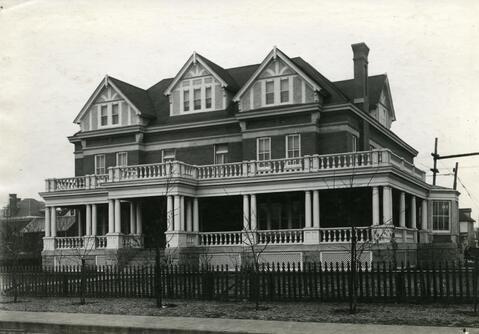
Title and statement of responsibility area
Title proper
Grayson House in Moose Jaw
General material designation
- Graphic material
Parallel title
Other title information
Title statements of responsibility
Title notes
Level of description
Item
Reference code
Edition area
Edition statement
Edition statement of responsibility
Class of material specific details area
Statement of scale (cartographic)
Statement of projection (cartographic)
Statement of coordinates (cartographic)
Statement of scale (architectural)
Issuing jurisdiction and denomination (philatelic)
Dates of creation area
Date(s)
Physical description area
Physical description
1 photograph: b&w; 16.5 cm x 11.5 cm
1 negative
Publisher's series area
Title proper of publisher's series
Parallel titles of publisher's series
Other title information of publisher's series
Statement of responsibility relating to publisher's series
Numbering within publisher's series
Note on publisher's series
Archival description area
Name of creator
Biographical history
Lewis Rice owned Rice’s Studio that was located in Moose Jaw, Saskatchewan and offered services in photography, illustration and publication. "The Buckle of the Greatest Wheat Belt in the World" was published by Rice’s Studio in 1913.
Rice was born in Bedeque (now Baddeck), Cape Breton Island, Nova Scotia in 1862 and demonstrated artistic abilities at an early age. He moved to Moose Jaw with his wife in 1906 and was an active member of the community. He was a local business owner, the vice-president of the Board of Trade and the founder of the Aquatic Club. A photographer, illustrator, and publisher, Lewis Rice illustrated for the Board of Trade and the Canadian Pacific Railway (CPR). His photographs won multiple awards, including top awards at the Dominion Fair in Toronto in 1912. Rice died October 14, 1913 in Moose Jaw.
Custodial history
Scope and content
Image of the Grayson House on Stadacona Street West in Moose Jaw, Saskatchewan. It is a three-story house, owned by the Grayson family, with columns supporting a covered porch.
Notes area
Physical condition
Immediate source of acquisition
Arrangement
Language of material
Script of material
Location of originals
Original no. 79
Availability of other formats
Restrictions on access
Terms governing use, reproduction, and publication
Copyright: Public Domain
Please credit the Moose Jaw Public Library Archives Department.
Finding aids
Uploaded finding aid
Associated materials
Accruals
General note
William Grayson came to Saskatchewan in 1883 after graduating from Osgoode Hall Law School in Toronto, Ontario. One of the pioneers of the City of Moose Jaw, he established a general practice of law to serve the residents of Moose Jaw and surrounding communities. After working as a sole practitioner, he formed a partnership with Charles Ernest Armstrong, Thomas Emerson and Lester McTaggart.
The Grayson family established roots in the City of Moose Jaw and was connected with the City's growth and development over the years. William Grayson acted as mayor for the City in 1903. William Grayson passed away suddenly in 1926, but left behind his reputation for integrity, entreprenuership, and care for the local community. His law practice was assumed by his partners, and his family continued with his legacy when his son, Charles Douglas Grayson, became associated with his father's firm.
Alternative identifier(s)
Standard number area
Standard number
Access points
Subject access points
Place access points
Name access points
- Rice, Lewis (Subject)
- Grayson family (Subject)

